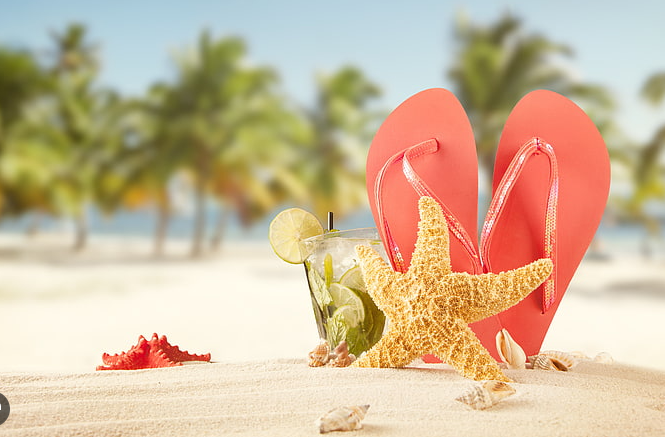Flip flops are a type of sandal that features a Y shaped strap called a “toe thong.” The strap runs from the top of the flip flops where it splits into two to form the Y shape. The two ends of the strap are placed around both sides of the foot. The sole is flat and lightweight. Sandals are probably the oldest type of footwear in the world. They feature one or more straps attached to the sole. The main strap typically runs from one side of your instep to the other. They are available in a variety of designs.

Simple distinctions:
Design
Sandals are a broad category of open-toed footwear that consists of a sole (the bottom part that comes in contact with the ground) and straps that secure the shoe to the foot. The design can vary widely, and sandals may have multiple straps, a single strap, or even enclosed toes.
Flip flops, on the other hand, are a specific type of sandal characterized by a Y-shaped thong that goes between the first and second toes, with a sole that typically consists of a flat piece of rubber or foam. They are simple and minimalist in design.
Usage
Sandals are generally considered more versatile and can be worn in a variety of settings, from casual to formal. They are available in different styles, including gladiator sandals, wedge sandals, and more. Some sandals have a back strap, while others are backless.
Flip flops are usually considered very casual and are often associated with beachwear or relaxed settings. They are easy to slip on and off, making them convenient for quick trips or outings.
Occasions
Sandals can be appropriate for a wider range of occasions, including beach outings, casual walks, and even more dressy events when they are designed with a formal or decorative flair.
Flip flops are typically not considered appropriate for formal or dressy occasions. They are commonly worn at the beach, pool, or during informal outdoor activities.
Material
As previously mentioned, flip flops are generally characterized by their lightweight construction. This is primarily attributed to their typical use of materials such as rubber, foam, plastic, or hemp. Although the thickness of the sole may vary, flip flops are typically designed with a minimal amount of material. Consequently, the production cost of a pair of flip flops is usually quite affordable, catering to consumers with budget constraints.
Appearance
While both flip flops and sandals incorporate straps attached to the sole, their aesthetics and designs are fundamentally distinct. Both types of footwear offer a range of color options and textures. However, flip flops typically exhibit a Y-shaped strap as their defining feature. In contrast, sandals often employ multiple straps that crisscross the wearer’s foot. Furthermore, sandals can be fashioned with either flat soles or elevated heels/wedges, resulting in a generally more stylish and sophisticated appearance. Sandals are available in a diverse array of styles, spanning from simple and understated to glamorous and elegant. For example, there are styles like gladiator sandals that feature intricate straps wrapping around the lower leg. Due to this versatility in design, this type of san.
Ankle Support
The most conspicuous and significant disparity between flip flops and sandals lies in the presence of an ankle strap designed to offer ankle support. Without this strap, your footwear remains unsecured to your feet, resulting in the soles “flip-flopping” while you walk. In essence, sandals provide superior foot support due to the inclusion of an ankle strap, which is typically equipped with features such as metal buckles or Velcro for fastening.
Shape
When it comes to short-term comfort, you shouldn’t have a problem choosing sandals or flip flops. Both provide breathability, perfect for relieving your feet from being enclosed in shoes all day at work. However, if you’re planning on walking around wearing this type of footwear for an entire day, sandals are the far superior choice. This is because sandals often feature soles that have an ergonomic design. They are shaped to provide extra comfort since people typically use them for longer periods of time. Flip flops, on the other hand, have a thin, flat shape which can cause foot fatigue if worn for more than a few hours.
In contrast, sandals are known for their sturdier build, mainly due to the use of thicker materials in the sole construction. While sandals, like flip flops, may incorporate rubber in their design, manufacturers also employ materials like leather, cork, wood, or fabric. These additional materials contribute to the durability and more shoe-like qualities of sandals.
Sandals or Flip Flops: Ultimately, It’s a Matter of Personal Preference
Undoubtedly, there exist noticeable distinctions between sandals and flip flops, sufficient to set them apart from each other. While both styles of footwear are ideal for warm weather, they are by no means interchangeable when it comes to factors like design, structure, support, and occasion. Naturally, it’s beneficial to keep these differences in mind when deciding to purchase a pair. However, the ultimate choice largely comes down to personal preference. Moreover, there’s no reason why you can’t indulge in both styles, catering to various occasions and personal tastes.
In summary, while flip flops are a specific type of sandal with a distinct design, sandals encompass a broader category of open toed footwear with various styles and designs, some of which are suitable for more formal occasions. Check out all of our sandals and flip flops options to find the best style for you. If you have any question, please contact Heva for more imformation.